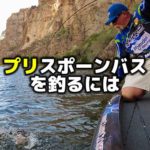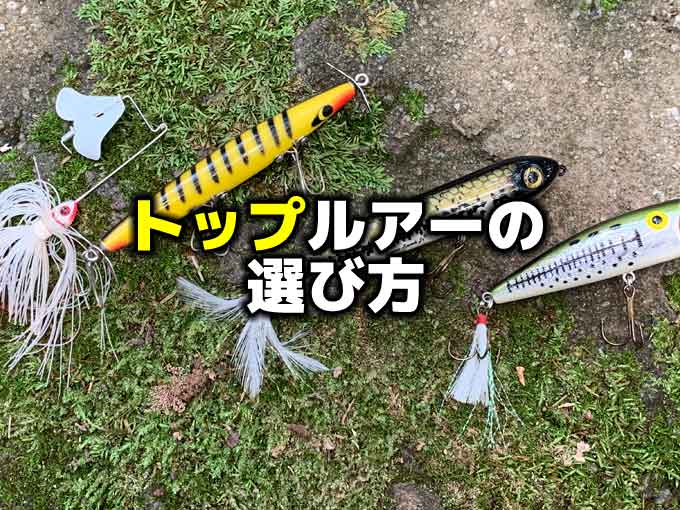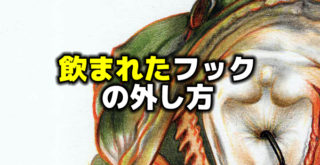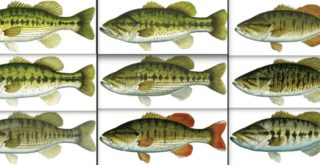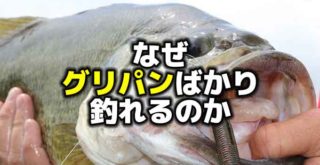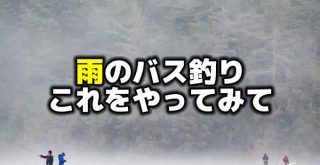究極のシューティング、ダミキリグとは?②(全2回)

Photo by flwfishing.com
こんにちは!店長の小山です!
本日も海外サイトより、”FISHING THE DAMIKI RIG IN WINTER”という記事を引用してご紹介いたします!
引用先:flwfishing.com”FISHING THE DAMIKI RIG IN WINTER”February 8, 2017 by Curtis Niedermier(海外サイトです)
「シューティング」でバスを釣るというこのメソッド、前回記事は背景やタックルなどの解説でしたが、今回は使い方などの実践編となります。
全2回中の2回目です→前回の記事はこちら
それでは読んでみましょう。
いつ、どこで釣るべきか

Photo by flwfishing.com
The Damiki rig is primarily a wintertime bait, though according to Snavely it has some applications earlier in the season, beginning at about the autumnal equinox in late September. From then until November on the mountain lakes near his Johnson City, Tenn., home, Snavely finds bass grouped together in larger schools than in wintertime. They also relate more to the bottom rather than being suspended. So Snavely targets flats, humps and points and tends to fish the rig with a bit more action.
Later in the year, when the rig really shines, he’s primarily dead-sticking for suspended bass or bass keyed on suspended bait in water deeper than 30 feet. Shallower than that, the fish can be spooked by the boat overhead.
Water temperature is also important for the winter bite.
“Anything 50 degrees or below is good, but 46 to 48 degrees is best,” Snavely says. “You’re mimicking sluggish shad that start to die off when it’s cold. Target any bank, channel, channel swing, ditch or flat where there’s bait.”
Unlike in summer, when offshore bass tend to relate to a defined edge, winter smallmouths can be just about anywhere as long as food is nearby. Shad, alewives and other baitfishes will filter in and out of the main lake and large creeks through ditches, down the center of the creeks or along steep-sloping banks.
That’s why it’s essential to focus on finding bait, versus spending hours searching for schools of bass along distinct contours. Besides, sometimes bass “blend in” with schools of bait on the depth finder and are tough to spot anyway, or they’re so tight to bottom – waiting on bait to drift by overhead – that they’re not visible on the graph.
“A lot of times you just idle around, and you only have to see one fish because they’re so tight to bottom [that you don’t see the rest],” Snavely adds. “It’s not like the summertime where you want to see a bunch of fish schooled up.”
If you mark a fish or two, or if you locate a wad of bait, stop and drop the trolling motor. Snavely says he finds more fish once he shuts off the big motor and is on the front deck, with the bait dropped down.
Finally, weather is a major factor in winter. The fish respond to fronts as they do at any time of year, but strong winds make it tough to stay directly above them, and the resulting waves crashing on banks can set up other patterns that are easier to fish, such as casting a swimbait or crankbait along steep, windblown banks and points.
Cold days and extended periods with low temperatures are usually better than mild days, and sunshine will cause bass to suspend more often, making them more susceptible to the Damiki rig. When they’re suspended, Snavely has found that the fish can be patterned by depth range, so once you find a few, check similar areas elsewhere on the lake.
ダミキリグは主に冬のルアーですが、スナヴェリーによると、9月下旬の秋分から始まるシーズンの早い時期でも適用できます。テネシー州の近くのハイランドレイクでは、11月にかけて、スナヴェリーは冬期よりも大規模なスクールと一緒にいるバスを見つけます。それらは、サスペンドというよりもむしろボトムにもっと関連している。そのためスナヴェリーは、フラット、ハンプや岬をターゲットにして、もう少しアクションを加えて釣る傾向があります。
リグが真価を発揮する秋から、彼は主に9メートルより深いディープでサスペンドしているバスまたはサスペンドしたベイトを食っているバスに対し主にデッドスティッキングさせます。それよりも浅いときは、ボートが頭上にいることで魚がスレてしまいます。
冬のバイトを取るには水温も重要です。
「10℃以下なら良いのですが、7.7℃から8.8℃が最適です」とスナヴェリー氏は言います。 「寒くなって次々に死んでいくシャッドを模倣するのです。バンク、チャンネル、チャンネルが曲がるところ、溝、またはベイトが多い場所をターゲットにしてください。」
夏のオフショア(沖)のバスは明確なエッジに関連している傾向があるのに対し、冬のスモールマウスは食べ物が近くにある限りどこにでも移動します。シャッドやその他のベイトフィッシュは、メインレイク内外の大きな川のミオ筋、小川の流芯部や、急な斜面のバンク沿いにもいます。
だからこそ、別の等深線沿いのバスを探すための時間をかけるよりも、ベイトフィッシュを探すことに集中することが不可欠です。さらに、時にはバスが魚探に映るベイトに「混ざり合って」いたり、とにかく見つけるのが難しい場合も含め、ボトムにべったり貼りついて頭上をベイトが流れてくるのを待っているときなども、画面上には表示されません。
「多くの時間を無駄に過ごしてしまい、そして、ようやく一本の魚を見つける状況です。[ボトムにべったりの魚は見つけづらいだけですが]」スナヴェリーはつけ加えます。 「たくさんの魚のスクールが見える夏のようにはいかないのです」
1匹や2匹の魚にマークを付けた場合、またはベイトフィッシュを見つけた場合は、そこで止めてエレキを降ろしてください。スナヴェリーは、エンジンを止めてデッキのフロントへ行けば、より多くの魚とベイトフィッシュが真下で見つけられると言います。
最後に、天気は冬の大事な要因です。魚は1年中いつでも前線に敏感ですが、強風のために真上にとどまるのが難しく、結果的に波がバンクにぶつかっている場合などは、他の釣りやすいパターンに切り替えます。風の当たる急なバンクや岬に沿ってスイムベイトやクランクベイトを投げるなどです。
寒い日や低温が長期間続いた場合は、通常、穏やかな日よりも優れていて、日差しによりバスがより頻繁にサスペンドし、ダミキリグに影響を受けやすくなります。スナヴェリーはバスがサスペンドしているときは、同じ深さの範囲でパターン化していることを発見したので、いくつかを見つけたら、湖の他の場所で同様の場所を確認してみてください。
ダミキリグの釣り方
Fishing the Damiki rig is a bit of a departure from traditional vertical presentations. Unlike a spoon, which is usually jigged and ripped aggressively, or a drop-shot, which is shaken in place, the Damiki rig works best with a dead-sticking presentation.
Snavely often uses it in conjunction with a 2.8-inch Keitech swimbait rigged on a 1/4-ounce jighead. Sometimes the fish show a preference for one or the other. But when they’re on the Damiki rig, that’s when he knows a big bag is possible.
“You definitely get bigger bites on it than the Keitech. I don’t know why,” he says. “But sometimes if they don’t bite you can back off and cast the Keitech and get them to bite.”
To fish the Damiki rig, Snavely starts by setting the frequency on his bow-mounted Lowrance HDS unit to the 200 kHz frequency, and he shuts off his rear graph to eliminate interference. If he has a co-angler on board who’s using the rear graph, he sets the front graph to the medium CHIRP sonar setting.
He works into the wind for control, and eases along at a modest speed, stopping above fish whenever they show up on the graph or just dangling the rig in areas where he believes fish to be.
“Don’t get into a hurry on the trolling motor,” Snavely adds. “If you get in a hurry you’ve gone past them.”
ダミキリグの釣りは、伝統的なバーチカルプレゼンテーションとは少し違います。通常ジギングのように積極的に上下させるメタルジグ、またはその場で誘うドロップショットとは異なり、ダミキリグはデッドスティッキングプレゼンテーションが最も効果的です。
スナヴェリーは、1/4オンスのジグヘッドに付けられた2.8インチのケイテック・スイムベイトと組み合わせて使用することもよくあります。だいたい、魚はそのどちらかに好みを示します。しかし、彼がダミキリグを使うとき、それはビッグウエイトの可能性があることを知っているときです。
「間違いなくケイテックを使うよりもビッグバスがバイトしてくる。なぜかわからないが」と彼は言う。しかし、ビッグバスのバイトがなければ、ケイテックをキャストし、バイトを得ることができます。
ダミキリグで釣るために、スナヴェリーは、バウ側の Lowrance HDSユニットの周波数を200kHzの周波数に設定することから始め、干渉を避けるためにリアの魚探をオフにします。リアの魚探を使用したい同船者がいる場合、フロント魚探を中程度のCHIRPソナー設定にします。
彼は風をうまく制御し、風に沿って穏やかな速度で進みつつ、魚が画面上に浮かび上がったり、魚がいると信じている場所に差し掛かると、魚の上に止め、リグを投入し釣りをします。
「エンジンをつかって急いではいけない」とスナヴェリー氏は付け加えた。急いでしまうと、それらを見過ごしてしまいます。

Photo by flwfishing.com
Tempting a bass to bite is a cat-and-mouse game. If Snavely sees a fish on his graph, he drops his bait down and stops it a few feet overhead. If he knows fish are in the area, but can’t see them on the graph, he drops his bait down to within 5 or 10 feet of the bottom. Even though these fish might be hugging the rocks, they’re aggressive enough to swim up a long distance to eat an easy meal. Other times, a fish will come into view above his bait, and he has to readjust quickly.
“If you see one up at, say, 17 feet, reel up past it and stop, and usually it will eat it,” he says.
Regardless of where and how a fish shows up, he keeps the rig above the bass and doesn’t give it any action; in fact, he holds it still. Usually if the fish is willing to swim up toward the bait, it’s going to bite. If it doesn’t, Snavely has a few tricks.
“If one stalls, raise up,” he says. “The farther you can get one to come up, the more likely it is to commit.
“A lot of times what gets them fired up is when you reel up really quick and then drop it back down,” he adds.
バスにバイトさせることを誘惑することは、イタチごっこなのです。スナヴェリーさんが画面上に魚を見ると、彼はルアーを落としてバスの数10センチ上で止めます。彼は魚がそのエリアにいるのを知っていますが、画面上で魚を見ることができない状況だと判断した場合は、底から1.5~3メートル上にルアーを落とします。これらの魚は岩に付いているのかもしれませんが、楽に食事を摂るために遠くまで泳ぐほど積極的です。その場合でも、もし画面上に魚がルアーの上に映ってきたとしたら、すぐに対応してください。
「もし自分が釣っているレンジより上に写ったら、例えば水深5メートルラインとします。すぐにそれを巻き戻して5メートルよりすぐ上で停止してください。通常はそれでバイトします」と彼は言います。
魚がどこにどのように現れても、彼はバスの上にリグを保ち、止めておきます。実際に彼はそうしています。通常、魚がルアーに向かって泳ぎはじめたら、バイトに持ち込めるでしょう。もしそうでなくても、スナヴェリーはまだいくつかの手段も持っています。
「うまくいかなかったら、持ち上げてみてください」と彼は言います。 「遠く離したほうが上手くいく場合もあります。多くの場合、彼らのスイッチが入るのは、本当に素早く巻き上げて、また元に戻すときです」と彼は付け加えます。
Mastering this cat-and-mouse game is the most challenging part of the technique, but it’s also an exciting way to fish. Pay particularly close attention to the bottom band on the depth finder. Sometimes a bass will rise up just far enough off bottom to create a noticeable sonar return that blends in slightly with the bottom. If you see a sudden change in color or thickness of the band, it might be a fish.
Also, if a bass shows up, but quickly disappears, sometimes you can relocate it by turning the trolling motor head. The resulting transducer angle change can bring the bass back into the sonar cone.
The key to the technique is to read the fish and respond to their cues – and to be willing to venture out in cold water and look for fish in the first place. Once you find them, the Damiki rig is an effective tool to pluck them from the depths, and you might be rewarded with some of the biggest bass of the season.
このイタチごっこをマスターすることは、このテクニックの中で最も難しい部分ですが、魚を釣るにはエキサイティングな方法です。特に魚探のボトムレンジには細心の注意を払ってください。時にはバスがボトムからちょっとだけ浮き上がり、ボトムとわずかに触れてるよう見えるソナーの画像を作り出すことがあります。カラーやボトムの厚さが突然変化した場合、それは魚かもしれません。
また、バスが表示されてもすぐに消えてしまった場合は、エレキを回して移動させ戻ることもできます。その結果トランスデューサーの位置が変わり、バスをソナーの範囲内に戻すことができます。
この技術の鍵は、魚探に映る魚の反応を読みとれるかというところにあり、そもそも、寒い冷たい水に繰り出して魚を探す気があるかということです。ひとたびそれらを見つけてしまえば、ダミキリグは、ディープからバスを釣るための効果的なツールであり、あなたはそのシーズンの最大レベルのバスで報われるかもしれません。
いかがでしたか。
ダミキリグを使ったシューティングの釣り。読めば読むほど、野尻湖で使えそうですよね!
主に冬の釣りということでしたが、応用すれば秋からでもできるということですので、まさに野尻湖っていう感じです。
ベイトの群れがより深くなる10月中旬以降、メタルジグやキャロシャッドで釣るのが今までのセオリーでした。もちろんシューティングの釣りが得意な方はそれで釣っていたのでしょうけども、この釣りが新しい野尻湖の釣りになるとまた面白くなりそうですね!
まあ、実際のところは簡単ではなさそうな気もしていますが、本文でも書かれている通り、大事なのはバスとベイトを探す気があるのかどうかということでしたので、一番はガッツだぜということですかね(笑)
とりあえず、魚探の周波数を200khzにセットして、湖上へ出てみましょうか!
それでは、また。
毎度ありがとうございます!









